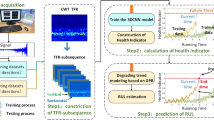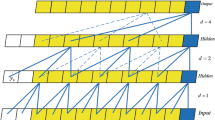Abstract
Aiming at the limitation of early fault warning and the diagnosis of aero-engine main bearing when there are only normal operation data, a rolling bearing fault evolution state indicator based on deep convolutional neural network (CNN) and wavelet analysis was proposed. To be specific, firstly, the wavelet band envelope method was adopted to identify the early fault evolution process, and the feature distance between the degraded data and the normal ones was extracted by using deep CNN to develop the evolution state indicator. Then, the evolution stages were divided by using unsupervised clustering method. Finally, the remaining useful life (RUL) was predicted based on particle filter (PF). Three different groups of whole life cycle data of rolling bearings under various working conditions were used to prove the feasibility of the indicator. The results show that the wavelet-CNN features of completely different fault data show similar evolution trends, and the normalization of warning threshold can be realized based on the train labels. In conclusion, the results are of great significance for the early fault evolution monitoring, condition evaluation and remaining useful life prediction of rolling bearings without the absence of fault samples under actual aeroengine operation.
Similar content being viewed by others
References
B. A. Tama, M. Vania and S. Lee, Recent advances in the application of deep learning for fault diagnosis of rotating machinery using vibration signals, Artificial Intelligence Reviews, 56 (2023) 4667–4709.
C. Y. Yang, J. Ma and X. D. Wang, A novel based-performance degradation indicator RUL prediction model and its application in rolling bearing, ISA Transactions, 121 (2022) 349–364.
A. R. Bastami and S. Vahid, A comprehensive evaluation of the effect of defect size in rolling element bearings on the statistical features of the vibration signal, Mechanical Systems and Signal Processing, 151 (2021) 107334.
T. Lin, G. Chen and W. L. Ouyang, Hyper-spherical distance discrimination: a novel data description method for aero-engine rolling bearing fault detection, Mechanical Systems and Signal Processing, 109 (2018) 330–351.
M. M. M. Islam, A. E. Prosvirin and J. M. Kim, Data-driven prognostic scheme for rolling-element bearings using a new health index and variants of least-square support vector machines, Mechanical Systems and Signal Processing, 160 (2021) 107853.
H. L. Luo, L. Bo and X. F. Liu, A novel method for remaining useful life prediction of roller bearings involving the discrepancy and similarity of degradation trajectories, Computational Intelligence and Neuroscience, 2021 (2022) 2500997.
J. H. Zhou, Y. Qin and D. L. Chen, Remaining useful life prediction of bearings by a new reinforced memory GRU network, Advanced Engineering Informatics, 53 (2022) 101682.
M. Iqbal and A. K. Madan, CNC machine-bearing fault detection based on convolutional neural network using vibration and acoustic signal, Journal of Vibration Engineering and Technologies, 10(5) (2022) 1613–1621.
A. Choudhary, T. Mian and S. Fatima, Convolutional neural network based bearing fault diagnosis of rotating machine using thermal images, Measurement, 176 (2021) 109196.
R. K. Mishra, A. Choudhary and S. Fatima, A self-adaptive multiple-fault diagnosis system for rolling element bearings, Measurement Science and Technology, 33(12) (2022) 125018.
J. S. Yan, Y. Z. Peng and J. S. Xie, Remaining useful life prediction method for bearings based on LSTM with uncertainty quantification, Sensors, 22(12) (2022) 4549.
A. Jastrzebska, Lagged encoding for image-based time series classification using convolutional neural, Statistical Analysis and Data Mining, 13(3) (2020) 245–260.
X. Y. Zhang, G. Chen and T. F. Hao, Rolling bearing fault convolutional neural network diagnosis method based on casing signal, Journal of Mechanical Science and Technology, 34(6) (2020) 2307–2316.
C. Lu, Z. Y. Wang and B. Zhou, Intelligent fault diagnosis of rolling bearing using hierarchical convolutional network based health state classification, Advanced Engineering Informatics, 32 (2017) 139–151.
X. Y. Liu, G. Chen and T. F. Hao, A combined deep learning model for damage size estimation of rolling bearing, International Journal of Engine Research, 24(4) (2023) 1362–1373, DOI: https://doi.org/10.1177/14680874221086601.
H. M. Chen, Z. H. Lei and F. Y. Tian, A novel complex network community clustering method for fault diagnosis, Measurement Science and Technology, 34(1) (2022) 014010.
A. Neha, S. Subhamoy and M. Laurent, Estimation of local failure in tensegrity using interacting particle-ensemble Kalman filter, Mechanical System and Signal Processing, 160 (2021) 107824.
L. Li, A. F. F. Saldivar and Y. Bai, Battery remaining useful life prediction with inheritance particle filtering, Energies, 12(14) (2019) 2784.
Acknowledgments
This research is sponsored by National Science and Technology Major Project (J2019-IV-004-0071), National Natural Science Foundation of China (52272436).
Author information
Authors and Affiliations
Corresponding author
Additional information
Xiyang Liu is a Ph.D. candidate in the College of Civil Aviation, Nanjing University of Aeronautics and Astronautics, Nanjing, P. R. China. Her current research interests include deep learning and pattern recognition, and their applications in bearing fault diagnosis of aero engine.
Guo Chen received a Ph.D. degree in the School of Mechanical Engineering from the Southwest Jiaotong University, Chengdu, P. R. China, in 2000. Now he works at the College of General Aviation and Flight, Nanjing University of Aeronautics and Astronautics, Nanjing, P. R. China. His current research interests include the whole aero-engine vibration, rotor-bearing dynamics, rotating machine fault diagnosis, pattern recognition and machine learning, signal analysis and processing.
Rights and permissions
About this article
Cite this article
Liu, X., Chen, G., Wei, X. et al. A rolling bearing fault evolution state indicator based on deep learning and its application. J Mech Sci Technol 37, 2755–2769 (2023). https://doi.org/10.1007/s12206-023-0504-8
Received:
Revised:
Accepted:
Published:
Issue Date:
DOI: https://doi.org/10.1007/s12206-023-0504-8




